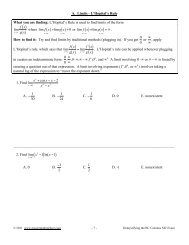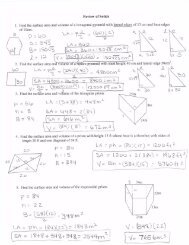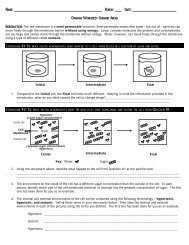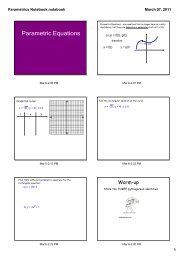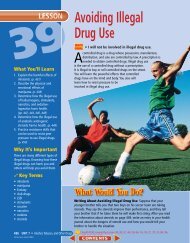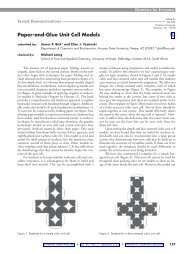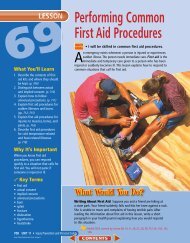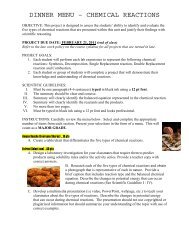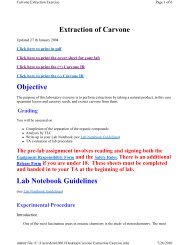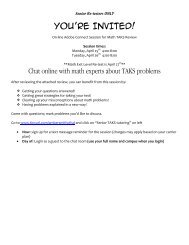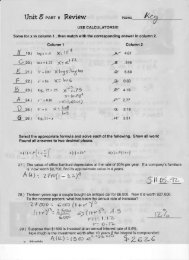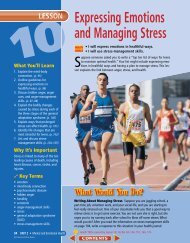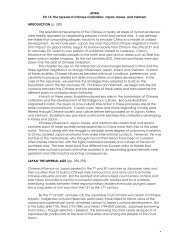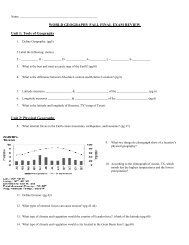You also want an ePaper? Increase the reach of your titles
YUMPU automatically turns print PDFs into web optimized ePapers that Google loves.
PARTS OF THE PROMPT<br />
First, let’s look at what this prompt asked you to do:<br />
Read the following passage from Joyce Carol Oates’s novel We Were the<br />
Mulvaneys (1996). Then, in a well-organized essay, analyze the literary<br />
techniques Oates uses to characterize the speaker, Judd Mulvaney.<br />
Support your analysis with specific references to the passage.<br />
Before you even start annotating, you should identify the<br />
CONCRETE and ABSTRACT parts of the question.<br />
CONCRETE (i.e. what you are analyzing)<br />
Literary techniques – left up to you – start with DIDLS!<br />
No matter what – it is always expected that you address TONE.<br />
ABSTRACT (i.e. what your analysis proves)<br />
How Oates characterizes Judd Mulvaney<br />
Also, remember ATTT! (Author, Title, Type, Time)<br />
Joyce Carol Oates is a lady, not a man! Missing the gender of the<br />
writer is a sure sign you didn’t give the prompt more than a moment’s<br />
glance. Also, you’re not on a first name basis with the writer, so use her<br />
last name in reference.
You DO NOT have time to just read! You must read and THINK!<br />
If you’ve taken time to break down the prompt, then you should know<br />
what you’re looking for during your read through of the passage.<br />
Make an annotation key.<br />
Looking at your annotations, was there a systematic way that you mark<br />
quotes for different literary techniques you identified?<br />
<strong>Here</strong> you could have color-coded, but on the AP Test all you have it a<br />
pen. Come up with a way to make a key, so you have a visual road map<br />
for your thoughts. Use boxes, circles, underlines, squiggles – whatever<br />
works FOR YOU to break it apart.<br />
So now that you’ve done all this work, you have to USE IT.<br />
Everything you write in your essay should be directed from what you’ve<br />
annotated.<br />
You don’t have to use everything you’ve marked, but at least you’ve<br />
given yourself options. You’ve got to do the editing in your head though!
IMPORTANT LITERARY TECHNIQUES USED<br />
You could have just gone with the basics (DIDLS): diction,<br />
imagery, details, language, and syntax<br />
Word choice unusual for a young boy<br />
Nature-based sensory language<br />
Repetition of key phrases<br />
Mixture of fragments and run-ons<br />
UNIQUE LITERARY TECHNIQUES USED<br />
Or you could stretch yourself and look for the things “outside of<br />
the box” of normal literary analysis<br />
Use of asides in the parentheses<br />
“Stream of consciousness” thinker<br />
Death motif
TONE – GLOOMY, PESSIMISTIC, THOUGHTFUL, LONELY, ETC.<br />
TONE is defined as the writer or speaker’s attitude toward the subject<br />
and audience.<br />
Why is this important? Tone is where all roads lead in analysis.<br />
The key for tone is identifying which tone is for what purpose. The tone<br />
towards the audience and the subject don’t have to be the same and<br />
usually are not!<br />
Tone towards himself?<br />
Tone towards his subject of the realization of death’s affects?<br />
CHARACTERIZATION OF JUDD MULVANEY – UNIQUELY AWARE,<br />
LONELY, BURDENED WITH KNOWLEDGE, ETC.<br />
Why is this important? It’s the part you’re proving by analyzing these<br />
techniques.
Chunky, isolation of strategies and parts – You’re looking at the piece as<br />
a whole, so analyze it by working through it from start to finish. Don’t isolate the<br />
elements (i.e. diction paragraph, tone paragraph, etc), but blend them together<br />
because that’s how they operate in the piece. Look for shifts in the narration as<br />
natural breaking points for your analysis.<br />
Vague, laundry list thesis statements – Your thesis is the foundation of<br />
your paper. If you thesis is not specific enough, how can you expect your<br />
argument to be?<br />
Vague – Oates characterizes Judd Mulvaney as a lonely and thoughtful boy; she achieves this by<br />
using the literary techniques of repetition, syntax, imagery, and point of view.<br />
So, basically you’re saying she used words that were some times repeated with sentences that were<br />
structured and they all painted pictures for the audience of Judd’s view.<br />
Specific – …the main character, Judd Mulvaney, is characterized as a slightly eccentric, scatterbrained<br />
individual with great adoration for his family, which is shown through Oates’s use of<br />
repetition of key phrases, peculiar syntax, and a complete interior dialogue that is shown to the<br />
reader.<br />
Don’t define terms – Know your audience! The reader of your timed writing is<br />
educated; therefore, a lesson in language analysis vocabulary is unnecessary.<br />
Refrain from using those nonessential appositives after terminology.
Not enough evidence – One piece of evidence is not enough to be<br />
representative for a whole strategy or a paragraph. You need to use snippets of<br />
evidence throughout the piece.<br />
Too much evidence – Evidence must be balanced with analysis. You can’t<br />
just sprinkle quotes in at random to “spice up” your essay. They have to have a<br />
purpose and add to your analysis. Additionally, avoid using whole sentences<br />
unless you’re going to break it down into smaller segments. Otherwise, it’s<br />
obvious that you’re just using up space to increase the size of your paragraph.<br />
Sketchy evidence – One to two word quotes are shady at best. How does the<br />
reader know that you have not taken them out of context? What can you<br />
realistically analyze about a single word?<br />
Generalizations & Oversimplifications – Remember, just because it<br />
happens once in a piece, doesn’t mean it hold true throughout the entire work.<br />
Writer’s arguments are complex; there are shifts in tone and purpose that have<br />
to be taken into account.<br />
Unnecessary Summary – Just like in your formal essays, the reader doesn’t<br />
need an interpreter to tell us what we’ve just read. Use your intro to identify that<br />
you understand the basics of the argument so that the body of your essay is free<br />
to analyze it.



